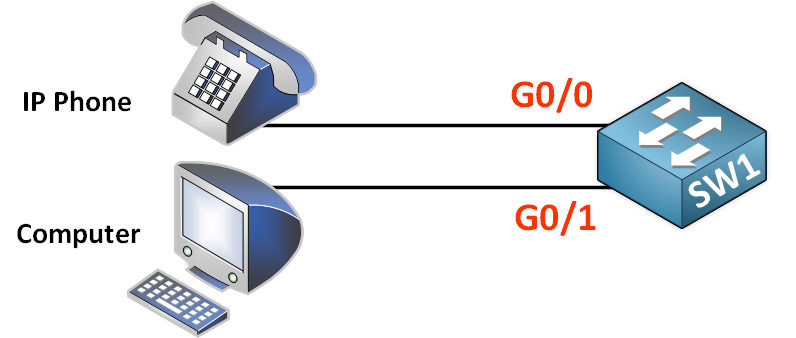Voice VLAN
1. Purpose of Voice VLAN
A Voice VLAN is designed to separate and prioritize VoIP (Voice over IP) traffic on a network. By isolating voice traffic from data traffic, it ensures high-quality audio communication, reducing latency, jitter, and packet loss.
Initial Configuration Challenges
Traditionally, connecting a computer and an IP phone to a switch required two cables:
- One cable connecting the computer to the switch.
- Another cable connecting the IP phone to the switch.

This approach has several disadvantages:
- It requires additional cabling, increasing installation complexity.
- It consumes two switch ports per workstation, reducing port availability.
2. Understanding Voice VLAN
To address these challenges, modern IP phones (such as Cisco models) include an integrated three-port switch:
- One port connects the phone to the switch.
- One port connects the computer to the phone.

This setup enables shared cabling while logically separating traffic using VLANs:
- The data VLAN handles computer traffic.
- The Voice VLAN (also called Auxiliary VLAN) manages IP phone traffic.
When connected, the switch port acts as a trunk for the phone, forwarding untagged traffic (from the computer) and tagged traffic (from the phone). Only the data and Voice VLANs are allowed on this trunk.

3. Configuring Voice VLAN
Configuration Steps

Let’s configure a Voice VLAN using VLAN 10 for data and VLAN 20 for voice:
- Create the VLANs:
SW1(config)# vlan 10 SW1(config-vlan)# name DATA SW1(config-vlan)# exit SW1(config)# vlan 20 SW1(config-vlan)# name VOICE SW1(config-vlan)# exit
4. Configure the switch port:
SW1(config)# interface GigabitEthernet 0/0 SW1(config-if)# switchport mode access SW1(config-if)# switchport access vlan 10 SW1(config-if)# switchport voice vlan 20 SW1(config-if)# exit
- VLAN 10 is used for computer traffic.
- VLAN 20 is used for voice traffic.
- Enable VLAN Discovery:
- Cisco IP phones use CDP (Cisco Discovery Protocol) to learn which VLANs to use.
- Other phones may use LLDP-MED (Link Layer Discovery Protocol – Media Endpoint Discovery) for this purpose.
4. Verifying and Troubleshooting Voice VLAN
Verify VLAN Configuration
Use the following command to verify the switch port settings:
SW1# show interfaces GigabitEthernet 0/0 switchport Name: Gi0/0 Switchport: Enabled Administrative Mode: static access Operational Mode: static access Administrative Trunking Encapsulation: negotiate Operational Trunking Encapsulation: native Negotiation of Trunking: Off Access Mode VLAN: 10 (DATA) Trunking Native Mode VLAN: 1 (default) Administrative Native VLAN tagging: enabled Voice VLAN: 20 (VOICE)
Check Allowed VLANs
Even though the interface operates as a trunk, the allowed VLANs are limited to the data and Voice VLANs:
SW1# show interfaces GigabitEthernet 0/0 trunk Port Mode Encapsulation Status Native vlan Gi0/0 off negotiate not-trunking 1 Port Vlans allowed on trunk Gi0/0 10,20 Port Vlans allowed and active in management domain Gi0/0 10,20 Port Vlans in spanning tree forwarding state and not pruned Gi0/0 10,20
5. Conclusion
With this configuration, you can efficiently connect both a computer and an IP phone using a single port and cable, while ensuring logical separation of traffic. The Voice VLAN setup improves network performance and maintains call quality by prioritizing voice traffic.
This approach simplifies network management, conserves switch ports, and enhances the user experience in environments where VoIP is critical.
